Cite this document
(Educational Psychology in Nowadays Environment Essay, n.d.)
Educational Psychology in Nowadays Environment Essay. https://studentshare.org/psychology/1714255-educational-psychology
Educational Psychology in Nowadays Environment Essay. https://studentshare.org/psychology/1714255-educational-psychology
(Educational Psychology in Nowadays Environment Essay)
Educational Psychology in Nowadays Environment Essay. https://studentshare.org/psychology/1714255-educational-psychology.
Educational Psychology in Nowadays Environment Essay. https://studentshare.org/psychology/1714255-educational-psychology.
“Educational Psychology in Nowadays Environment Essay”. https://studentshare.org/psychology/1714255-educational-psychology.


